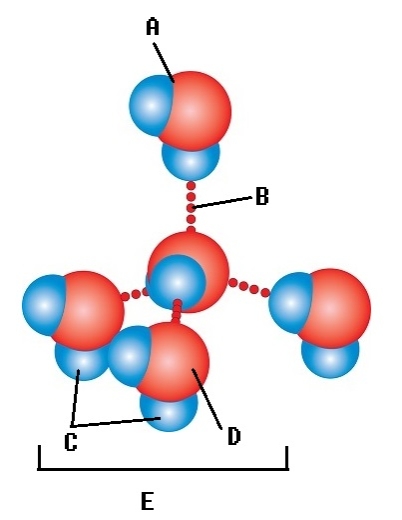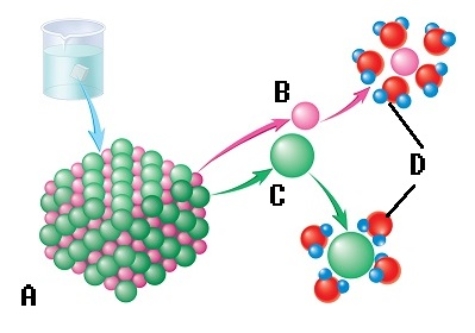A) serves as the energy currency of the cell.
B) can store, but cannot release energy in the cell.
C) is a sugar found in transfer RNA.
D) stores genetic information.
E) is a nucleotide found in DNA.
G) None of the above
Correct Answer

verified
Correct Answer
verified
True/False
The term mass describes the material that makes up all living and nonliving things.
B) False
Correct Answer

verified
Correct Answer
verified
Multiple Choice
For most chemical reactions, an increase in temperature will cause the reaction rate to
A) remain unchanged.
B) increase.
C) decrease.
E) A) and C)
Correct Answer

verified
Correct Answer
verified
Multiple Choice
Intermolecular forces are weak electrostatic attractions that exist between
A) two atoms
B) two molecules
C) two protons
E) A) and B)
Correct Answer

verified
Correct Answer
verified
Multiple Choice
 -Water accounts for 50% of the weight of a young adult female and 60% of a young adult male. What kind of molecule is found at "E"?
-Water accounts for 50% of the weight of a young adult female and 60% of a young adult male. What kind of molecule is found at "E"?
A) water molecule
B) polar covalent bond
C) hydrogen atom
D) oxygen atom
E) hydrogen bond
G) A) and B)
Correct Answer

verified
Correct Answer
verified
Multiple Choice
Arrange the following from largest to smallest: (1) nucleus (2) DNA molecule (3) skin cell (4) chicken eggs
A) 1, 2, 3, 4
B) 4, 2, 3, 1
C) 4, 3, 1, 2
D) 3, 4, 2, 1
E) 2, 3, 1, 4
G) A) and B)
Correct Answer

verified
Correct Answer
verified
Multiple Choice
An organic molecule consists of carbon, hydrogen, oxygen, nitrogen, and sulfur; the molecule is probably
A) an amino acid.
B) a triglyceride (fat) .
C) carbon dioxide.
D) a phospholipid.
E) a monosaccharide.
G) A) and B)
Correct Answer

verified
Correct Answer
verified
Multiple Choice
Which of the following organic groups does lactose belong to?
A) protein
B) nucleic acid
C) carbohydrate
D) lipid
E) vitamin
G) A) and C)
Correct Answer

verified
Correct Answer
verified
Multiple Choice
The molecular formula H2O means
A) 1 hydrogen atom and 2 oxygen atoms.
B) 1 hydrogen atom and 1 oxygen atom.
C) 2 hydrogen atoms and 1 oxygen atom.
D) 2 hydrogen atoms and 2 oxygen atoms.
E) None of these choices is correct.
G) A) and C)
Correct Answer

verified
Correct Answer
verified
Multiple Choice
The mass number of an atom is the number of
A) electrons plus neutrons in the atom.
B) neutrons in the atom.
C) neutrons plus protons in the atom.
D) protons in the atom.
E) protons plus electrons in the atom.
G) A) and C)
Correct Answer

verified
Correct Answer
verified
Multiple Choice
Normal pH for blood is 7.35 to 7.45. Maintenance of the pH in this range is
A) critical because enzymes work best within narrow ranges of pH.
B) not critical because extreme pH values do not affect enzyme function.
C) called denaturation.
D) not required.
E) None of these choices is correct.
G) A) and B)
Correct Answer

verified
Correct Answer
verified
Multiple Choice
 -The sodium chloride molecule breaks apart in water. What does "B" represent?
-The sodium chloride molecule breaks apart in water. What does "B" represent?
A) chloride ion
B) dissociation
C) water molecule
D) sodium ion
E) salt crystal
G) All of the above
Correct Answer

verified
Correct Answer
verified
Multiple Choice
Which of the following pairs is mismatched?
A) hydrolysis - water is used in decomposition reaction
B) synthesis reaction - two reactants combine to form a larger product
C) decomposition reaction - large reactant broken into smaller products
D) dehydration reaction - water is a product of the reaction
E) oxidation - gain of electrons
G) A) and E)
Correct Answer

verified
Correct Answer
verified
Multiple Choice
The amount of matter in an object is its
A) element.
B) mass.
C) ionic charge.
D) atomic number.
E) weight.
G) A) and E)
Correct Answer

verified
Correct Answer
verified
Multiple Choice
Kinetic energy is
A) movement of ions or electrons.
B) energy that moves in waves.
C) energy that flows between objects with different temperatures.
D) the form of energy that actually does work.
E) stored energy that could do work but is not doing so.
G) B) and D)
Correct Answer

verified
Correct Answer
verified
Multiple Choice
Potential energy is
A) stored energy that could do work but is not doing so.
B) movement of ions or electrons.
C) the form of energy that actually does work.
D) energy that flows between objects with different temperatures.
E) energy that moves in waves.
G) B) and E)
Correct Answer

verified
Correct Answer
verified
Multiple Choice
Eicosanoids
A) are structural proteins.
B) comprise the genetic material.
C) are components of the plasma membrane.
D) play a role in the response of tissues to injuries.
E) are fat-soluble vitamins.
G) B) and D)
Correct Answer

verified
Correct Answer
verified
Multiple Choice
Lipids
A) serve as buffers.
B) are polarized.
C) are an important component of cell membranes.
D) tend to be water soluble.
E) are subunits of carbohydrates.
G) B) and E)
Correct Answer

verified
Correct Answer
verified
Multiple Choice
Covalent bonds form when
A) atomic nuclei fuse.
B) electrons are shared between two atoms.
C) neutrons are transferred from one atom to another.
D) molecules become ionized.
E) protons are lost from atoms.
G) B) and C)
Correct Answer

verified
Correct Answer
verified
Multiple Choice
Lipids
A) function as enzymes.
B) yield little energy per unit of weight.
C) comprise the genetic material of cells.
D) are all water soluble.
E) can insulate and help prevent heat loss.
G) B) and E)
Correct Answer

verified
Correct Answer
verified
Showing 41 - 60 of 168
Related Exams